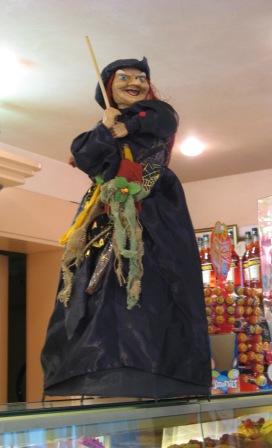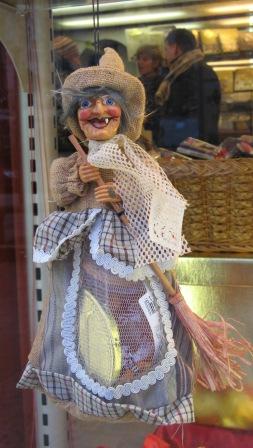The Befana, that bountiful old beldam, has more work to do than just to bring goodies to the kids and carry away the holidays.
On January 5 (the eve of the feast of the Epiphany — the eve being the day on which the profane elements of a festival are usually celebrated) several ancient rituals are observed in Italy going under various names. In the Veneto these customs are knotted together under the generic term panevin (pan-eh-VEEN). And the focal activity isn’t bread and wine — though there are naturally comestibles — but to brusar la vecia (broo-ZAR ya VEH-cha). Burn the old woman.
If you were to be in Venice on the night of January 5 and smelled smoke, you might want to check with someone before calling the firemen. Tonight, in fact, if the wind is from the east, I will be able to step outside and smell the smoke coming from bonfires along the lagoon’s farming coastline.
Technically speaking, this sort of agricultural festival would more appropriately be observed toward March, closer to the beginning of the annual cycle of cultivation, and not during what is still pretty much the dead of winter. In a few communities they do wait till the exact mid-point of Lent to “burn the old woman.” I suspect it’s because by then they’re desperate for some kind of festivity.
The central element of panevin is a bonfire composed of pieces of dead wood (from grapevines, olive trees, or anything else you have pruned or otherwise dismembered to encourage its growth), and atop this bonfire, tied to the stake which holds the mass of leftover wood together, is the effigy of an old woman, the Befana. Yes, she too is intended to go up in flames.
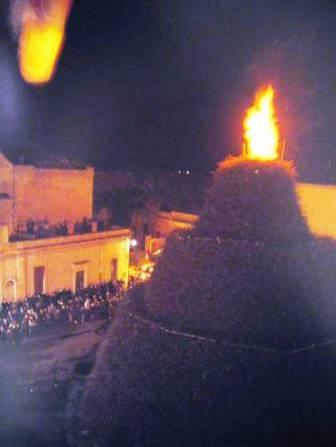
Then again, in some towns, such as Novoli, the people burn their bonfire, a phenomenal ziggurat 36 meters [118 feet] high of dead vine branches, on January 17 in honor of St. Anthony Abbot, a major agricultural deity — sorry, I mean saint. I have my own memories of being there in 2003 researching “Italy Before the Romans” (National Geographic, January 2005). They let me climb to the top, the first woman — and an American, no less — ever to be permitted to do this. The next night the fire fizzled almost completely and I got out of town early, to avoid any recriminations of having brought bad luck. But back to the vecia.
Naturally any custom that strikes roots down to this level of antiquity contains several aspects, some contradictory, and not easy to confirm. But the general consensus is that bonfires played a central role in the ancient rituals of the Celts, who left other marks on the Veneto; the fire evoked, if not incited, the return of the sun from the solstice and the gradual lengthening and warming of the days. In the Christian religion, Epiphany was the day on the Julian calendar which coincided with December 25 on the Gregorian. (I know that December 25 is not the winter solstice, but I didn’t invent these customs.) And then the idea was planted/grafted/germinated spontaneously to hold the bonfire on Epiphany in order to light the way to Bethlehem for the Three Kings, who had traversed a bit too afar and gotten lost.
So we have to have fire, partly to represent/propitiate the sun, and partly because we’ve got loads of dead wood and other useless stuff that has to be incinerated anyway. Lino remembers when people would improvise their own bonfires right here in the city, in the neighborhood campos. As you can imagine, the firemen eventually put a stop to that.
Somebody or something has to serve as the sacrificial figure — deities require sacrifice — and an old human easily represents the old year, the old sins, the old crud and detritus and misfortune of the year just past. Some theories posit that the figure represents winter. Throw it all on there; all this stuff needs to be destroyed and fire in itself, besides being impressively effective in the destruction department, contains large amounts of symbolic meaning focused on purification.
Why does the figure have to be a woman? I’m still seeking the reason(s) for that one. One of the few I’ve found so far says that the female figure represents the Celtic priestess. There is also the point that Strenia (or Strenua), a Sabine goddess of strength and endurance adopted by the Romans, was venerated at the beginning of the year (one custom was the exchange of gifts; a Christmas gift is still called a strenna). Hence a woman. Let’s move on.
So we’ve got a fire, therefore naturally we’ve got smoke. And sparks. There will be a breeze. Now we come to the core of the ceremony, which is to study the direction the sparks are blown in order to predict how this year’s crops will fare.
The video above was made in Vittorio Veneto, a town about 80 km [50 miles] from Venice, toward the mountains. One hint are the men with the single black feather in their wool hats who are distributing the refreshments; these are members (or ex-members) of the Alpini, the mountain regiment of the Army. I’m sorry about the fruity TV music — it isn’t anything you would hear played at this event.
There are versions of the prognostication formula in scores of regional dialects, but the one I hear around Venice goes like this: “Se le falive (fa-EE-veh) va a marina/tol su saco e va a farina/se le falive va a montagne/tol su saco e va a castagne.” “If the sparks go toward the sea (east), take your sack and go to make flour (wheat); if the sparks go toward the mountains (west), take your sack and go gather chestnuts.”
Thus: Eastward-blowing sparks mean a good year is coming. If they head west, you’re going to be reduced to making your flour (bread, sustenance) from chestnuts, which is pretty much your last resort before starving. The fact that some not-bad dishes can be made with chestnut flour doesn’t change the fact that wheat is much, much better.
Let me note that the formula of divination in some areas, while being essentially the same, carries the opposite meaning: East is bad, west is good. So don’t blame me if your sparks don’t turn out to have told the truth.
Naturally all this burning and auguring is an excuse for a party (very few things here are not). We went one year to a small town on the mainland to celebrate the panevin, and after we had studied the sparks and coughed a while from the smoke, we went to the makeshift tables where vin brule’ (hot spiced wine) and pinza were being offered.
Wine needs no justification, and drinking it hot in sub-zero darkness is a great thing. If you haven’t got alcohol you haven’t got a party, and you can find easily find vin brule’ all winter.
But this is the only time of year you’ll get pinza. It is essentially the traditional winter-Veneto-panevin fruitcake, the only difference being that people actually eat pinza. This was the classic Christmas sweet before panettone horned in; it involves cornmeal, wheat flour, dried figs, anise seeds and bits of candied fruit. My trusty cookbook of old Venetian recipes includes raisins, sugar, pine nuts, and two eggs. Other recipes invoke walnuts, fennel seeds, and grappa. (Traditional offerings to Strenia were figs, dates and honey). However it’s made you won’t want a big wedge, it’s got a specific gravity rivaled only by mercury.
I hope you have a superb 2010, no matter where your sparks blew.

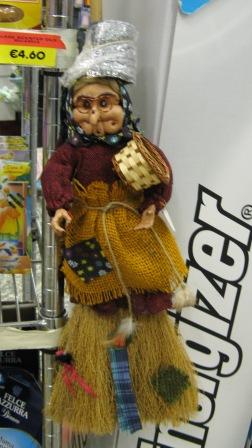 For most of us, New Year’s Day represents the end of the holiday season. Not here. We still have the Epiphany to celebrate (January 6), and it comes swooping through, not so much in the person of the Re Magi (Three Kings) whom we recall brought gold, frankincense and myrrh to the infant Jesus, but instead in the person of a broom-borne hag called the “Befana,” a name that got squeezed out of Epifania (Eh-pee-FAH-neeyah).
For most of us, New Year’s Day represents the end of the holiday season. Not here. We still have the Epiphany to celebrate (January 6), and it comes swooping through, not so much in the person of the Re Magi (Three Kings) whom we recall brought gold, frankincense and myrrh to the infant Jesus, but instead in the person of a broom-borne hag called the “Befana,” a name that got squeezed out of Epifania (Eh-pee-FAH-neeyah). 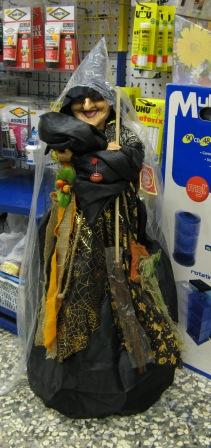 Her imminent arrival explains all the Halloween-like witches you will have seen cluttering pastry-shops, bakeries, bars and cafes, supermarkets, and anywhere else someone with small people might be likely to pass. Sometimes, but not always, she will be tied or stapled to a stocking already stuffed with assorted chocolates, chewing gum, hard candies, and any other little item that could send you into sugar shock.
Her imminent arrival explains all the Halloween-like witches you will have seen cluttering pastry-shops, bakeries, bars and cafes, supermarkets, and anywhere else someone with small people might be likely to pass. Sometimes, but not always, she will be tied or stapled to a stocking already stuffed with assorted chocolates, chewing gum, hard candies, and any other little item that could send you into sugar shock.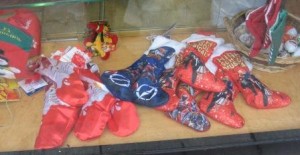 The fact that Father Christmas, Saint Nicholas, and assorted other gift-givers have already come through town hasn’t made a dent in this old custom, and so Venetian children today can, at least theoretically, scorch the holiday earth from December 6 to January 6. The term “enough,” let alone “too many,” has never been known to apply to presents.
The fact that Father Christmas, Saint Nicholas, and assorted other gift-givers have already come through town hasn’t made a dent in this old custom, and so Venetian children today can, at least theoretically, scorch the holiday earth from December 6 to January 6. The term “enough,” let alone “too many,” has never been known to apply to presents.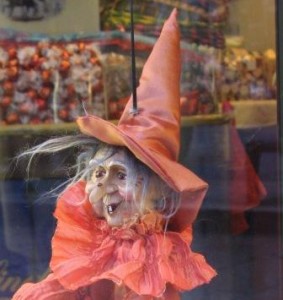 But the children were hospitable — they left out refreshments for the flyby Befana: A plate of pasta e fasioi (pasta and beans) and a glass of red wine, just the thing to warm an old lady stuck out in the cold all night. The plate and glass were empty the next morning, thereby confirming her existence, but eventually any child began to make some calculations. If this Befana eats beans at every house, then (A) how does she avoid death by explosion and (B) how the hell does she get manage to get airborne?
But the children were hospitable — they left out refreshments for the flyby Befana: A plate of pasta e fasioi (pasta and beans) and a glass of red wine, just the thing to warm an old lady stuck out in the cold all night. The plate and glass were empty the next morning, thereby confirming her existence, but eventually any child began to make some calculations. If this Befana eats beans at every house, then (A) how does she avoid death by explosion and (B) how the hell does she get manage to get airborne?